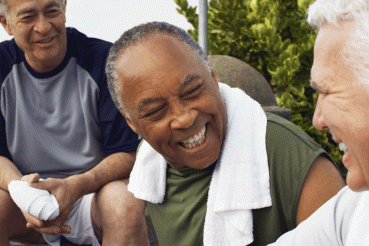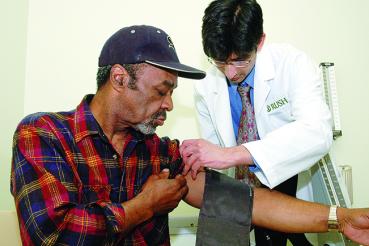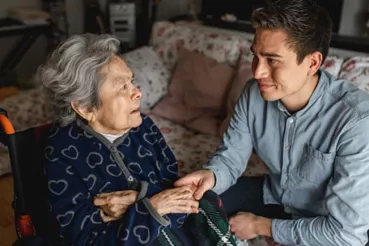Among older adults, falls are the leading cause of fatal and non-fatal injuries — hip fractures, broken bones, head injuries and more. And whether a fall causes injury or not, it can affect quality of life: Older adults with a fear of falling often limit their activities and run the risk of depression, social isolation, and loss of physical ability.
Here, Sandra Swantek, MD, a geriatric psychiatrist at Rush University Medical Center, shares five tips for working with the older adults in your life to help minimize their risk of falls.
1. Start the conversation, even though it can be difficult.
If you’re a caregiver or family member concerned about an older adult in your life falling, starting a dialogue is the place to begin, says Swantek.
It can be a tough topic to talk about: According to the Centers for Disease Control and Prevention, more than one out of four older adults fall each year, but less than half of those who fall tell their doctors about it — possibly because they are embarrassed, or because they fear losing their independence.
Swantek recommends a careful and respectful approach: “It can feel denigrating. Imagine someone telling you that you’re too old to be on your own.”
If the older adult is your parent, asking a physician or a trusted relative (such as a sibling) to bring up the topic can be less fraught.
2. Ask questions and listen closely.
If you’ll be the one having the conversation, an excellent way to begin is to ask, “Have any of your friends fallen?” (The answer is highly likely to be yes.) From there, ask follow-up questions: “What happened, and what did they say about it?” “Do you have any worries about that happening to you? What do you worry about?” “What do you think we might do about it?”
This path, says Swantek, lets the older adult lead the conversation and maintain a sense of control and dignity while addressing their concerns. “Often, older adults’ greatest fear is that they’ll break a hip and have to go to a nursing home,” Swantek says, “so it pays to get them to talk about things you can do to help them avoid that.”
3. Advocate for a physician assessment.
A thorough assessment by a physician can help identify potential issues that can contribute to instability when walking, such as the following:
- Certain medications, including benzodiazepines and antidepressants, can cause drowsiness or dizziness.
- Deteriorating vision can make it difficult to see tripping hazards and obstacles.
- Foot pain or arthritis can cause gait changes that lead to tripping.
- Some chronic conditions, such as heart disease or diabetes, can contribute to a loss of function due to inactivity or pain.
4. Encourage exercise.
“The biggest risks for falls are lower body weakness and balance difficulties,” Swantek says, so an exercise program that builds strength and balance is the most helpful solution.
A physical medicine and rehabilitation physician or physical therapist may help with exercises and recommendations for aids like a cane or a walker if needed.
Another resource is Rush’s “A Matter of Balance” fall prevention workshop for older adults. For information about upcoming sessions, sign up to receive email and print newsletters from the Rush Generations program.
5. Create a safer environment at home.
Identifying and fixing falling hazards at home is easier when you use a checklist like this one from the CDC. It takes you through the home room by room and makes suggestions such as evaluating lighting; clearing floors of clutter and securing throw rugs; installing grab bars in tubs and next to toilets; and more.
And don’t forget about footwear: Make sure that shoes and slippers fit properly and aren’t slippery. If the older adult likes to wear socks around their home, find ones with treaded soles.
It can be difficult to talk about potentially sensitive issues like falls. But initiating that conversation and taking some simple preventive steps can both keep the older adults in your life safe and give you peace of mind.




